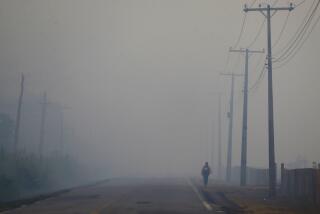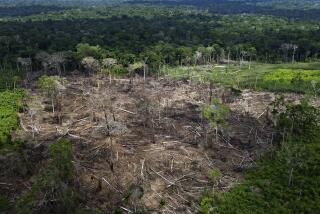Project Sets Out to Mend Besieged Brazilian Forest
- Share via
MAQUINE, Brazil — High in a tangle of creepers and branches in the Atlantic Forest, Maria Luiza Klippert strikes “green gold”--the fruit of a heart-of-palm tree.
It has taken Klippert, a geneticist, several days to find a fertile heart-of-palm, a once plentiful but now dwindling species prized for a soft, rich core that is often served in salads.
Using long shears, Klippert prunes hundreds of red fruits that contain the seeds she needs to grow new heart-of-palms. Then she climbs down a ladder 30 feet to the forest floor to gather her catch.
“As long as there’s a seed, there’s hope for a species,” she says. “Now we can reproduce the heart-of-palm and, with some luck, use them to regenerate the Atlantic Forest.”
The seeds will go to Brazil’s first “endangered tree bank”--a laboratory where scientists will reproduce species nearly wiped out by encroaching loggers, farmers and miners.
The tree bank is the centerpiece of an unusual World Bank project aimed at restoring Brazil’s Atlantic Forest, one of the world’s most diverse--and endangered--ecosystems.
The Ecological Corridor Project hopes to link pockets of surviving Atlantic Forest in the southernmost state of Rio Grande do Sul with “corridors” of new forest regrown with native species of plants and trees.
The corridors will connect patches of public and private land that are registered as “ecological protection zones” for tax breaks, said Daniel Gross, a task force manager for World Bank environmental projects.
“The old thinking was that you could only get some kind of ecological benefit from a forest if you set aside huge, unbroken chunks of land and kept people off them. But the government usually can’t afford to do that,” Gross said in a telephone interview from Washington.
“Now we see that if you link pieces of forest--public and private land that are managed by locals of the area--you can get the same environmental effect at a lot less cost.”
The $1.28-million project represents a major shift in World Bank funding away from immense projects drawn up by federal bureaucrats to smaller programs designed and implemented by scientists in the field.
“With those huge, centralized projects, we were losing a lot of money in bureaucrats’ salaries, workshops, planning and studies,” Gross said. “The studies are all right, but we really need action.”
The Atlantic Forest is, indeed, running out of time and trees.
When Portuguese explorers arrived in 1500, the wilderness spanned 4,500 square miles along Brazil’s coast. It covered 40% of what is now Rio Grande do Sul state.
Over the years, loggers, ranchers and farmers gnawed at the forest. And the more it shrank, the faster it was devastated. Between 1985 and 1990, government studies showed the Atlantic Forest was razed at a rate of 13 football fields an hour.
Today, just 3% of the nation’s original forest remains. In Rio Grande do Sul, a breadbasket built on cattle ranching and farming, just 2.3% is left.
Paradoxically, the more the Atlantic Forest disappears, the more scientists discover how biologically rich it is. In November, botanists in Bahia state discovered 476 types of trees in a 2.5 acre plot--a record for biodiversity.
A federal law was passed several years ago prohibiting logging of the forest, but enforcement was spotty and money was always short.
More to Read
Sign up for Essential California
The most important California stories and recommendations in your inbox every morning.
You may occasionally receive promotional content from the Los Angeles Times.













